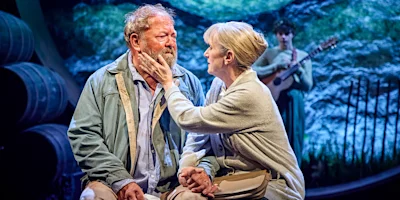
Learn about the real newsboys' strike that inspired the 'Newsies' musical
The hit musical follows young newspaper sellers taking on one of New York's most powerful news leaders.
More than a century before a group of actors sang and danced to "Seize the Day" on Broadway, a ragtag group of newsboys and girls actually seized the day by striking for their rights. The award-winning musical Newsies is based on that real-life story. Teenager Jack Kelly leads of a band of young newspaper sellers who refuse to work for Joseph Pulitzer, the owner of one of America's most-read newspapers, until he pays them fairly.
This high-energy, ever-timely Disney show, which won Tony Awards for its score and choreography in New York 10 years ago, makes its long-awaited UK premiere at the Troubadour Wembley Park Theatre in November. The new production immerses audiences into the world of 19th-century New York and all but sweeps them up in the strike themselves.
Before carrying the banner alongside the newsies in London and watching what happens in their struggle for workers' rights, learn about the true people and events that inspired Newsies and where the musical differs.
Book Newsies tickets on London Theatre.

Newsies is based on the newsboys' strike of 1899.
The Newsies musical is based on the 1992 Disney movie, which in turn is based on an actual historical event. First, a little background: Newspaper sellers had to buy papers from the publisher each day, and the newsies made their money back by upselling them. For a long time, most newspaper publishers charged the newsies 50 cents for 100 papers.
In 1898, however, the Spanish-American War broke out, so more people bought papers to follow the latest updates. Multiple publishers, including Joseph Pulitzer of the New York World and William Randolph Hearst of the New York Journal, thus decided to charge 60 cents per 100 papers, which the newsies accepted at first since they could still make a profit due to increased demand. Once the war was over and demand leveled off, most publishers lowered their price back to 50 cents. Pulitzer and Hearst did not.
So the World's and Journal's newsies went on strike. The strike lasted for two weeks in July of 1899, and the two papers' sales plummeted. The World, for one, sold about one-third of its usual number of papers per day during the strike. The turning point in the strike was a rally in Manhattan on 24 July 1899. More than 7,000 newsies from across all five New York City boroughs reportedly attended, and local politicans and businessmen gave speeches.
The Newsies musical takes small liberties with this history. In the show, the price gets changed during the war, and the newsies of Manhattan start the strike, whereas the first real-life strikers were in Queens. The Newsies Broadway and touring productions also featured a mostly male cast, though in real life, many girls also worked as newsies and participated in the strike. In newer productions, like the London one, the ensemble features male and female actors.
Newsies also focuses mostly on Pulitzer and the World; Hearst and the Journal are not a major part of the musical. They are mentioned, however, in the song "The World Will Know," whose title is a pun on the paper's name: "The World will know, and the Journal too. Mr. Hearst and Pulitzer, have we got news for you!"
The real strike, of course, ended in a successful agreement that changed the way newsies were paid for decades to come — but not before an apparent betrayal by the union leaders almost made the whole movement fall apart. Something similar happens in Newsies, but we won't spoil the show!

Multiple newsies and other characters are inspired by real-life people.
A couple of real people from the era of the strike are characters in Newsies. The most major one is Joseph Pulitzer (more on him later), the publisher of the New York World and the main antagonist of the show. Former President Theodore Roosevelt, then-governor of New York, makes a brief appearance in the musical. The final real-life character is William Randolph Hearst, who doesn't appear on stage in Newsies but is name-dropped a few times.
Most Newsies characters, though, aren't direct representations of real-life people, but reflect them in different ways. Jack Kelly is based on Kid Blink, the leader of the striking newsboys in 1899. Both Jack and Blink's parents are out of the picture, and neither boy uses his real name. Kid Blink's real name was Louis Baletti; his nickname refers to his singular eye. Jack Kelly is named for a 1950s Western film actor, a nod to Jack's desire to escape to Santa Fe. In the Newsies movie, his real name is Francis Sullivan, but that revelation was cut for the musical.
Other Newsies characters are related to real-life people in name only. The union president who led the strike with Kid Blink was named David Simmons, and Jack's right-hand man in the Newsies musical is named Davey. The reporter Katherine Plumber is named after Joseph Pulitzer's daughter, who in real life died in childhood. (Separately, Katherine in Newsies covers the strike for the New York Sun, a paper that extensively reported on the actual newsboy strike.)
Finally, three of the newsies in the show's ensemble are named for real-life boys from the 1899 strike: Spot Conlon, Racetrack Higgins, and Mush Meyers.

Joseph Pulitzer and the World were as powerful as Newsies makes them seem.
In fact, Pulitzer changed the face of journalism at the end of the 19th century — though not necessarily for good. He bought the flailing New York World in 1883 and soon grew it into America's most widely circulated newspaper, but his methods weren't fully honest.
He and Hearst, who bought the New York Journal in 1885, were bitter rivals, each wanting to beat the other in sales. They resorted to "yellow journalism," publishing exaggerated and even untrue stories with eye-popping headlines to entice readers. Small Spanish-American War scuffles became major battles, trivial trysts became sex scandals, petty crimes became mortal dangers.
The newsies even play a small part in this trend in the musical: When there are no interesting stories in that day's paper, they'll invent some to make a sale. "I'll make up a headline, and I'll say anything I have to," they sing in "Carrying the Banner." "You wanna move the next edition? Give us a earthquake or a war!"
But it's Pulitzer and Hearst's names that remain tightly linked with yellow journalism. That's not the only thing the men remain known for today, though: Hearst Media is still a major global company that owns dozens of TV stations, magazines, newspapers and more. Pulitzer is the namesake of the presitigious Pulitzer Prizes, and he led the charge to place the Statue of Liberty in New York during his second career as a congressman.
And of course, both are immortalized in theatre history once and for all as part of Newsies.
Book Newsies tickets on London Theatre.
Originally published on










